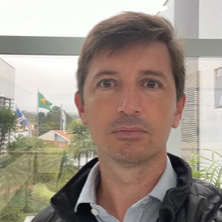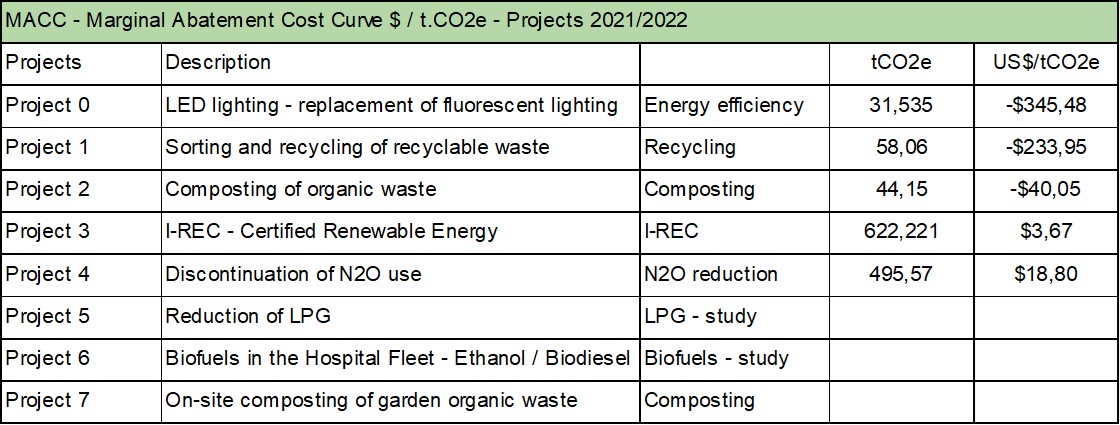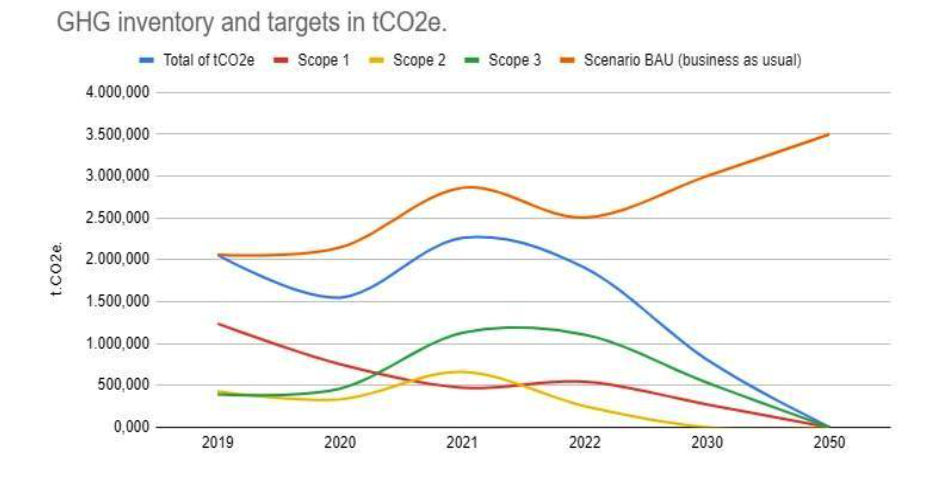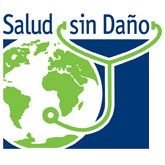Utilization of the MACC curve to define greenhouse gas reduction targets
Hospital do Rocio, Brazil
Case study summary
To set greenhouse gas reduction targets and commit Hospital do Rocio to the Race to Zero campaign and the Health Care Climate Challenge, a strategy will be employed using the marginal abatement cost curve (MACC) as a tool to analyze the efficiency of each project, considering emissions reduction and their costs in tCO₂e.
Demographic information
- City: Campo Largo
- State/province/region: Paraná
- Country: Brazil
- Type of institution: Private hospital
- Number of full-time staff: 67
- Number of part-time staff: 1,934
- Number of beds: 800
- Patient population served annually
- 272,411 patients served annually (inpatient and outpatient)
- Geographic area served: State of Paraná.
- Health equity concerns experienced by your population: The hospital performs approximately 90% of the care for patients coming from the Brazilian Unified Health System. This public health system guarantees the right to health for all Brazilians, as stated in the federal constitution of 1988. The accommodations have a maximum of two patients per room, facilitating individualized care and commitment to patient care quality and safety.
The issue
The first step in setting greenhouse gas reduction targets was the development of the GHG inventory, which included the 2019 and 2020 cycles. At that time, the targets seemed challenging to set and achieve, because it was not known how much CO2 each project could actually reduce. However, using the MACC, the values became clearer to observe, as well as the necessary investments and the potential reduction of GHG emissions for each project undertaken.
Hospital goal
Define a methodology of analysis that allows for evaluation of greenhouse gas emissions reduction projects and calculation of the related abatement potential.
Sustainability strategy implemented
After several attempts, the MACC tool was chosen because it presents the potential CO2e emissions reduction of each project clearly, considering the financial values that each ton of avoided carbon dioxide represents. The tool is a great option for selecting and prioritizing projects with the best cost-benefit ratio.

The development of the MACC Curve allows for the observation of projects that are most efficient in both economic and environmental aspects, facilitating the prioritization of projects for emissions reductions.
Implementation process
The Brazilian GHG protocol calculation tool was used to obtain data on the tCO2e that each project could reduce, based on the business as usual (BAU) scenario, which reflects the tendency of GHG emissions if no action was taken, such as the disposal of organic waste in landfills instead of composting as shown in table 1. The calculation was performed for each project in both the BAU scenario and the scenario with proposed improvements, using the GHG protocol calculation tool to project scenarios with implemented actions.

The cost is analyzed individually, so each project has its own calculation basis, which may be related to the value of kg of waste sent to the landfill, the value of MWH of energy, or the purchase of anesthetic gas. Since the implementation of the tool in 2022, five projects have been analyzed, of which four have already been implemented, as shown in graph 1. The maintenance engineering department and anesthesiology team provided important information for quantification in the analysis.

Tracking progress
The MACC methodology was effective in monitoring the targets set and achieved. The greenhouse gas emissions reduction target for the projects developed was 59% compared to the 2019 inventory. The recyclable waste, composting, and nitrous oxide disuse projects, which have already been completed, resulted in a 29% reduction in GHG emissions. The International Renewable Energy Certificates (I-REC) acquisition, which is currently being studied, has the potential to reduce emissions by 30%, neutralizing the scope 2 emissions of the inventory. Other projects are being developed with LPG Gas, Biofuel, and onsite composting.

Progress achieved
The results achieved with completed projects represent approximately 29% reduction in emissions. Projects involving waste management and recycling allocated 83.5 tons of materials for recycling and 62.3 tons of waste for composting. The project to discontinue the use of N2O and replace the anesthesia method generated the greatest share of emissions reductions in addition to benefits for patients, reducing time, and gains in post anesthesia recovery.
Challenges and lessons learned
Learning to use the GHG protocol calculation tool and the MACC was a major challenge, but conducting this study to set targets provided a better understanding of inventories and the use of the tool.
Next steps
Goals include completing the I-REC acquisition project to achieve the 50% greenhouse gas emissions reduction target set in the Race to Zero commitment, continuing the projects to reduce LPG consumption, and using biofuels in the hospital fleet.
